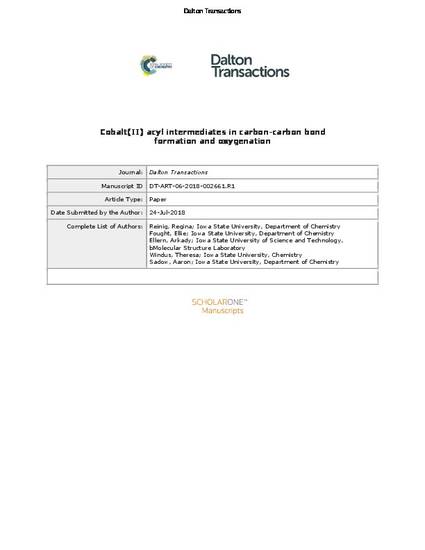
The organocobalt scorpionate compounds ToMCoR (ToM = tris(4,4-dimethyl-2-oxazolinyl)phenylborate; R = Bn, 1; CH2SiMe3, 2; Ph, 3; Et, 4; nBu, 5; Me, 6) react in carbonylation, oxidation, and carboxylation reactions via pathways that are distinctly influenced by the nature of the organometallic moiety. The compounds are prepared by reaction of ToMCoCl with the corresponding organolithium or organopotassium reagents. Compounds 1–6 were characterized by 8-line hyperfine coupling to cobalt in EPR spectra and solution phase magnetic measurements (μeff = 4–5μB) as containing a high-spin cobalt(II) center. The UV-Vis spectra revealed an intense diagnostic band at ca.700 nm (ε > 1000 M−1 cm−1) associated with the tetrahedral organocobalt(II) center that was assigned to a d ← d transition on the basis of configuration interaction (CI) calculations. Complexes 1–6 react rapidly with CO to form equilibrating mixtures of the low spin organocobalt carbonyl ToMCo(R)CO, acyl ToMCoC(O)R, and acyl carbonyl ToMCo{C(O)R}CO. The 1H and 11B NMR spectra contained only one set of signals for the CO-treated solutions, whereas the solution-phase IR spectra contained up to two νCO and three νC(O)R signals with intensities varying depending on the R group (R = Bn, 7; CH2SiMe3, 8; Ph, 9; Et, 10; nBu, 11; Me, 12). Single crystal X-ray diffraction of ToMCo{C(O)Et}CO (10) supports its assignment as a square pyramidal cobalt(II) acyl carbonyl complex. Upon evaporation of volatiles, solutions of 8–12 revert to the CO-free organocobalt starting materials 2–6, whereas attempts to isolate benzyl-derived 7 provide an unusual α-alkoxyketone species, characterized by single crystal X-ray diffraction. Despite the differences observed in the carbonylation of 1–6 as a result of varying the R group, compounds 7–12 all react rapidly with O2 through an oxygenation pathway to afford the corresponding carboxylate compounds ToMCoO2CR (R = Bn, 13; CH2SiMe3, 14; Ph, 15; Et, 16; nBu, 17; Me, 18). In contrast, the insertion of CO2 into the Co–C bond in 1–6 requires several days to weeks.
Available at: http://works.bepress.com/aaron_sadow/62/
